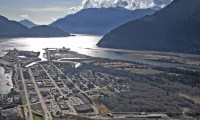Planning a demolition? Waste diversion is a requirement!
Since 2021, all demolition activity within the District of Squamish has been governed under The District of Squamish Demolition Waste Diversion Bylaw. Construction and demolition waste represent a major amount of divertible material* that contributes to the Squamish landfill filling up rapidly. Diverting demolition materials, especially wood, will help everyone in the community save money, lower greenhouse gas emissions, and extend the landfill’s lifespan.
Under this bylaw, a refundable fee of $20 per square metre is paid along with the Demolition Permit Application. When 80% or more of the waste is diverted by volume, the fee is refunded. Material can be sold or donated for reuse for double the diversion credit.
Did you know?
- Organics, including wood, are a major contributor to climate change if disposed of at the Squamish Landfill. When organics and wood waste break down, it creates methane, a greenhouse gas up to 72 times more powerful than C02 (measured over 20 years).
- Other common recyclable building materials including concrete, drywall, metal etc. can also be salvaged during renovation or demolition and reused in other building projects. By keeping materials circulating through the economy longer, we help reduce the waste that goes to the landfill.
If you are in the process of applying for a Demolition Permit and have questions about the process of complying with The District of Squamish Demolition Waste Diversion Bylaw, please contact the Outreach Sustainability Coordinator at zerowaste@squamish.ca.
*What is divertible material?
This means any material that can be composted, recycled or reused, including a material, substance, or object that is produced, originates or results from demolition and satisfies at least one of the following criteria:
- is organic material and is capable of being composted at a licensed facility;
- is managed as a marketable commodity with an established market by the owner or operator of a recycling facility;
- is being used in the manufacture of a new product that has an established market or is being processed as an intermediate stage of an existing manufacturing process;
- has readily available disposal options other than landfilling;
- is reused or repurposed; or
- is listed in Schedule B of The Solid Waste Bylaw but does not include hazardous materials.
February 17, 2023

Post your comment
Comments
No one has commented on this page yet.
RSS feed for comments on this page | RSS feed for all comments